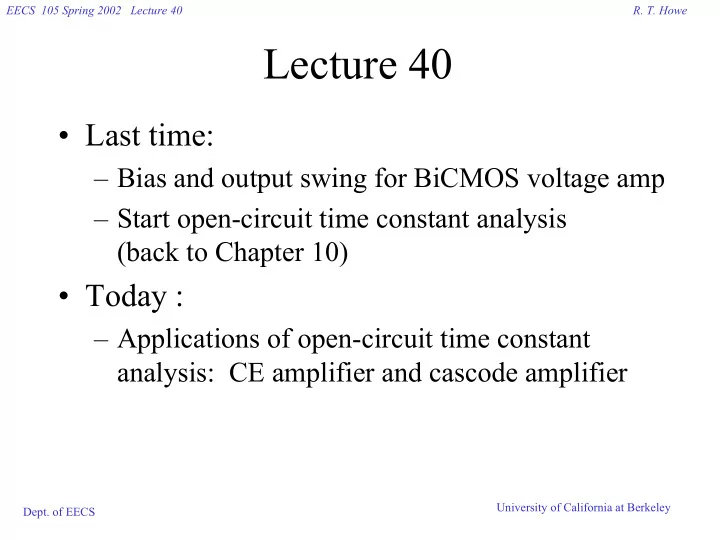

EECS 105 Spring 2002 Lecture 40 R. T. Howe Lecture 40 • Last time: – Bias and output swing for BiCMOS voltage amp – Start open-circuit time constant analysis (back to Chapter 10) • Today : – Applications of open-circuit time constant analysis: CE amplifier and cascode amplifier University of California at Berkeley Dept. of EECS
EECS 105 Spring 2002 Lecture 40 R. T. Howe Common-Emitter Voltage Amplifier Time constant for base-emitter capacitance C π : University of California at Berkeley Dept. of EECS
EECS 105 Spring 2002 Lecture 40 R. T. Howe Base-Collector Time Constant Must apply a test source (can’t see R T µ by inspection): University of California at Berkeley Dept. of EECS
EECS 105 Spring 2002 Lecture 40 R. T. Howe Solving for R T µ ( ) ′ = − = − Find v π : v i R || r i R π π t S t in ( ) ( ) ′ ′ ′ ′ = − = − = + v i R i g v R i 1 g R R Find v o : π o o out t m out t m in out ( ) ′ ′ = − = + − − v v v i 1 g R R ( i R ) Find v t : π t o t m in out t in Solve for Thèvenin resistance: University of California at Berkeley Dept. of EECS
EECS 105 Spring 2002 Lecture 40 R. T. Howe Dominant Pole of CE Amplifier Estimate dominant pole as inverse of sum of OCTCs: ( ) 1 − ′ ′ ′ ′ ′ 1 ω ≈ = + + + R C [ R R g R R ] C π µ 1 in in out m in out τ + τ C C π µ Identical to the “exact” analysis in Chapter 10 Why bother with the OCTC technique … add effect of C cs University of California at Berkeley Dept. of EECS
EECS 105 Spring 2002 Lecture 40 R. T. Howe Multistage Amplifier Frequency Response CS*-CB cascode University of California at Berkeley Dept. of EECS
EECS 105 Spring 2002 Lecture 40 R. T. Howe Systematic Approach 1. Construct two-port small-signal models for each stage 2. Add the capacitors for each device across the appropriate nodes in the two-port models. Make sure how the gate, drain, and source (or base, collector, and emitter) terminals of each device fit onto the two-port models! 3. (Optional) Use Miller’s Theorem to transform capacitors across amplifiers into effective capacitances to ground (note that we ignore the “output Miller” in this course) University of California at Berkeley Dept. of EECS
EECS 105 Spring 2002 Lecture 40 R. T. Howe Cascode Two-Port Model Add capacitors: C gs 1 , C gd 1 , C π 2 , C µ 2 … what about C db 1 , C cs 2 ? University of California at Berkeley Dept. of EECS
EECS 105 Spring 2002 Lecture 40 R. T. Howe Finding the Thèvenin Resistances gs = C gs 1 : R R TC S 1 ′ ′ ′ ′ = + + = C gd 1 : R R R g R R TC in out m 1 in out gd 1 = R C π 2 : TC π 2 = R C µ 2 : TC µ 2 University of California at Berkeley Dept. of EECS
EECS 105 Spring 2002 Lecture 40 R. T. Howe Dominant Pole Applying the theorem: ( ) − 1 ω ≈ + + + + R C R 1 g / g C ( 1 / g ) C R C π µ 1 S gs 1 S m 1 m 2 gd 1 m 2 2 L 2 Find approximate voltage transfer function: v r ( ) = = − β out o 1 A g r || r || R vo m 1 o o 2 oc 2 L + v r 1 / g s o 1 m 2 R , R S L University of California at Berkeley Dept. of EECS
EECS 105 Spring 2002 Lecture 40 R. T. Howe Gain-Bandwidth Product Metric for amplifier performance: note that ( ) * = ω ω = ω * A v j 1 A when vo 1 g R ω = m 1 L A ( ) vo 1 + + + + R C R 1 g / g C C / g R C π µ S gs 1 S m 1 m 2 gd 1 2 m 2 L 2 Special case: small R S g R ω ≈ A m 1 L vo 1 + C / g R C π µ 2 m 2 L 2 University of California at Berkeley Dept. of EECS
Recommend
More recommend